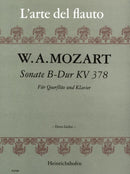| 作曲者 | Wolfgang Amadeus Mozart (1756-1791)・ヴォルフガング・アマデウス・モーツァルト |
| タイトル | Sonate B-Dur KV 378 op. 2 |
| サブタイトル | für Querflöte und Klavier |
| 出版社 | Heinrichshofen Verlag |
| シリーズ名 | L'arte del flauto |
| 楽器編成 | flute and piano |
| 品番 | mds9790204421916 |
| 校訂者 | Doris Geller |
| 形状 | 36 ページ |
| 出版番号 | N 2191 |
| ISMN | 979-0-2044-2191-6 |
| その他 | Serie "L'arte del flauto" |
| サンプル | http://assets.schott-music.com/Assets/Product/0/71/90/719004/500_MAVE/BSPSEITEN/HEIN_2191-01.jpg:: |
Mozart's favorite instrument was not the flute. This is generally known and can be seen from the fact that he only dedicated 4 chamber music works to it, namely the 4 quartets for flute, violin, viola and violoncello. Even the flute sonatas that have been available in print for a long time, the youth sonatas opus 10, 11, 12 and 13, are merely arrangements of sonatas for piano and violin. At the time, the term «piano» meant the harpsichord. It was only from around 1780 that «piano» usually meant the fortepiano. For example, in the manuscript of the Sonata in B flat major K. 378, composed in 1779, Mozart still expressly wrote the harpsichord. It was published in 1781 as part of the second series of 6 sonatas for piano and violin, whereby the order of the instruments mentioned is typical for this period: The piano is the main driver of the musical action and is accompanied by the melody instrument.
Mozart composed 35 sonatas for this instrumentation, but not a single one for flute! In order to give flute players the opportunity to play works by Mozart with piano, this violin sonata has been selected for arrangement. The work is well suited to the piano, so that no major changes had to be made in order to adapt the violin part to the technical requirements of the piano. Even the original key (B flat major) could be retained.
All the dynamic markings and articulation indications contained in the Urtext have been retained; only the legato slurs in the violin part have been altered in some places for the flute. Both dots and wedges as well as intermediate forms indicate the staccato in Mozart. For the sake of clarity, uniform dots have been used in this edition.
The dynamic indications in the piano part are not given for each hand separately, as is the case in Mozart's manuscript, but for both hands together, provided they are the same for both hands.
This edition enriches the repertoire of flutists with a valuable musical work and brings joy to all players.
- Allegro moderato
- Andantino sostenuto e cantabile
- Rondeau / Allegro



